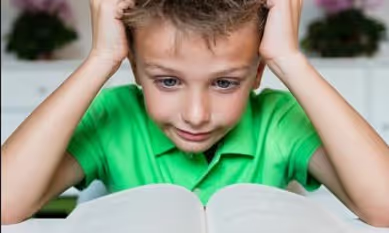Reading and learning difficulties - Impaired eye coordination

Reading and learning difficulties are not caused by low intelligence, but impaired coordination between several areas of the brain involved in collecting visual information, processing and understanding visual information, and storing the information. These dysfunctions can be triggered by several different causes. Including heredity, disrupted development as a result of premature birth, disrupted development as a result of physical or psychological trauma such as concussion or abuse, or it can be part of other diagnoses and developmental disorders such as ADHD or Tourette's syndrome.
Although there are several different causes of reading and learning disabilities, research shows that there may be more common functional disorders in people with reading and learning disabilities compared to those without. It turns out that children and adults with reading and learning disabilities also have impaired balance and coordination, impaired fine motor control over purposeful eye movements, and impaired coordination and processing of different movement information from the balance organ in the inner ear together with movement information from the neck and eyes. This makes it more challenging to collect and process the correct visual details and thus makes it more difficult to "crack" the reading code, understand the content of the sentences being read, and difficulties in learning and remembering the information being read.
When reading, it is important to have good fine motor control and coordination over the purposeful eye movements and fine-tuned coordination between movement information from the neck and head so that the eyes float in a controlled manner over the letters and words to be read. If you have impaired control over these functions, you can compare it to shaking your hand when filming with a video camera. The image becomes blurred and it becomes difficult to see and analyze the details properly, and you have to exert significantly more effort to maintain concentration. When your eyes do not float smoothly over letters and words, but instead skip past the letter or word you are trying to read. It becomes more challenging for the brain to put together the right letters into the right word and meaning. This can make it difficult to understand and remember the content of what you read, and when reading aloud, you may hear the person mispronounce the word or pronounce the wrong word. And has particular difficulty pronouncing long words.
Several research studies confirm that children and adults with dyslexia also have particular difficulties in performing the controlled purposeful eye movements required for reading and have impaired eye-hand coordination. Fine motor control and coordination over purposeful eye movements used in reading can be measured using videonystagmography (VNG). This is sophisticated computer-based equipment that maps which forms of uncontrolled eye movements the person has, and provides important information about which parts of the brain are malfunctioning. Along with a range of other advanced computer-based tests that challenge eye-hand coordination, balance, coordination and measure brain activity. We can map out how to tailor neurological rehabilitation that can improve how the brain coordinates and processes different movement information, and improve fine motor control and coordination over purposeful eye movements that can make reading and learning easier.
Videonystagmographies one of our standard tests for mapping brain dysfunction:
Research also shows that using the same type of exercises used to rehabilitate patients who have impaired fine motor control and coordination over purposeful eye movements after stroke, concussion, or dizziness and impaired balance can help improve purposeful eye movements in children and adults with reading and learning difficulties. This can include eye exercises, exercises that emphasize aligning movement information between the eyes, neck and balance organ in the inner ear, and coordination exercises with arms and legs.
The type of exercises that can help improve fine motor control and coordination over purposeful eye movements and improve eye-hand coordination is individual and must be adapted after a thorough examination. The BrainCamp team has extensive experience in examining and customizing neurological rehabilitation that can improve control and coordination of purposeful eye movements in people with reading and learning disabilities.
This video gives you an introduction to your first examination with us:
- Reference list:
- Aasef G. Shaikh and David S. Zee, 2017. Eye movement research in the twenty-first century- a window to the brain, Mind, and more. The Cerebellum. Published online December 19, 2017. Yasuo Terao et al, 2017. What do eye movements tell us about patients with neurological disorders? An introduction to saccade recording in the clinical setting. Proceedings of the Japan Academy. Series B, Physical and Biological Sciences 2017; 93 (10): 772-801.
- Andrew T. Duchowski, 2002. A breadth-first survey of eye tracking application. Behavior research methods, instruments & computers. November 2002, volume 34, issue 4, pp 455-470.
- Anita E. Pienaar et al, 2007. A review of the interrelationship between vestibular dysfunction. Motor and learing disabilities and the rehabilitation thereof. Sout African journal for research in sport, physical education and recreation. 29(1): 129-146, 2007.
- Chloe Prado et al, 2007. The eye movements of dyslexic children during reading and visual search: Impact of the visual attention span. Vision research, 47, 2521-2530, 2007.
- Frederick R. Carrick et al, 2016. Eye-movement training result in changes in qEEG and NIH stroke scale in subjects suffering from acute middle cerebral artery ischemic stroke: A randomized control trial. Frontiers in neurology, vol 7 (2016), article 3.
- Frederick R. Carrick et al, 2015. Short- and long-term effectiveness of a subject's specific novel brain and vestibular rehabilitation treatment modality in combat veterans suffering PTSD. Frontiers in Public Health vol 3 (2015), article 151.
- Gerry Leisman et al, (2010). The effect of hemisphere specific remediation strategies on the academic performance outcome of children with ADD/ADHD. International journal of adolescence medicine and health 2010;22(2):00-00
- John D.E Gabrieli and Elisabeth S. Norton, 2012. Reading abilities: Importance of visual-spatial attention. Current biology. Vol 22, no 9, 2012.
- Jinger Pan et al, 2014. Saccadic-target selection of dyslexic children when reading Chinese. Vision research, 97, 24-30, 2014.
- Michael Gallaway et al, 2017. Vision therapy for post-concussion vision disorders. Optometry and vision science 2017, volume 94 (1), p 68-73.
- Monica Biscaldi et al, 1994. Saccadic eye movements of dyslexic and normal reading children. Percetion, volume 23, page 45-64, 1994.
- Rokhsareh Badami et al, 2016. Effect of sport vision exercise on visual perception and reading performance in 7- to 10-year-old developmental dyslexic children. Journal of exercise rehabilitation. 2016; 12(6): 604-609.
- R. J. Leigh and Christopher Kennard, 2003. Using saccades as a research tool in the clinical neuroscience. Brain (2004), 127, 460-477.
- Sally A. Jones and Roger A. Shinto, 2006. Improving outcome in stroke patients with visual problems. Age and Ageing 2016; 35: 560-565.
- Timothy Belton and Robert A. McCrea (2000). Role of the Cerebellar Flocculus Region in Cancellation of the VOR During Passive Whole body Rotation. Journal of Neurophysiology, 84: 1599-1613, 2000.
- Wei Dong et al, 2012. Ischaemic stroke: the ocular motor system as a sensitive marker for motor and cognitive recovery. Journal of neurology, neurosurgery and psychiatry 2013; 84: 337-341.


